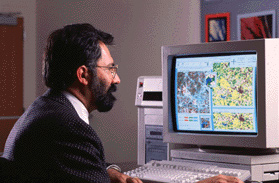| Home |
| Committees |
| CFP |
| Author Instructions |
| Program |
| Keynote Speakers (biographies) |
| Registration |
| Venue |
| Travel and Local Information |
| Colocated Workshops |
| ISCC (Main) |

Keynote Speakers
|
||
The State-Of-The-Art In Acquiring And Processing Satellite Remotely Sensed Data Worldwide. The conventional acquisition of imagery from space started in 1960s from a Gemini and Apollo spacecrafts that were followed in 1970s by Skylab and Landsat satellites. Since 1980s a large number of satellites have collected data routinely from the Earth by a number of countries including the U.S., French, Japanese, Indians, and Russians satellites. Today, a variety of satellite data are collected in many parts of the electromagnetic spectrum such as visible, infrared, and radar. The spatial, spectral, radiometric, and temporal resolutions of satellite data has grown finer and currently multispectral data collected in as fine as 61 cm. from the globe. Image processing techniques have progressed quite well with the advances in computer and electronics technologies. Along with these advances, the applications of remotely sensed data have advanced from global to large scale to local study areas. In this talk, we will address the current and future trends in satellite data acquisition, processing, and applications along with the roles information and communication technologies have played in these trends. A variety of satellite imagery will be demonstrated. |
||
|
||
Distributed Pattern Matching: Concept and Applications in Internet-scale networks. Peer- to- peer technology has impacted a wide range of distributed systems beyond simple file- sharing. Distributed XML databases, Distributed computing, server- less web publishing and networked resource/service sharing are only a few to name. Despite the diversity in applications, these systems share a common problem regarding searching and discovery of information.. This commonality stems from transitory peer population and volatile peer content. As an effect users do not have the exact information about what they are looking for. Rather queries are based on partial information, which requires the search mechanism to be flexible. On the other hand to scale with network size the search mechanism is also required to be bandwidth efficient. Since the advent of P2P technology experts from industry and academia have proposed a number of search techniques -pan> none of which is able to provide satisfactory solution to the conflicting requirements of search efficiency and flexibility. Structured search techniques, mostly DHT- based, are bandwidth efficient while semi(un)- structured techniques are flexible. But, neither achieves both ends. This talk will introduce a generic framework called Distributed Pattern Matching to address the search problem in distributed environments while achieving both search flexibility and efficiency. |
||
|
||
Ten Years of Experimentation in Information Mining & Software Research with applications in Telecommunications Industry This talk will contain an overview of AT&T Shannon Labs (the Research arm of AT&T Labs), and a more detailed discussion of our work in Information Mining and Software Research with applications in telecommunications industry including network operations, network security, IP network management, fraud detection, marketing, and business & consumer markets analysis. Over the past 10 years, AT&T Labs has had a focused program in information mining at very large scale. This has included inventing many tools & techniques, building quite a few applications, and collecting a few petabytes of telecommunications data. It also has included learning about what is useful and not so useful, possible and not so possible, and what directions we should be taking. Emphasis has been on near real-time mining; therefore on data streams, analysis within windows of data, and interactive visualization with record and playback. This talk will review some of the tools, techniques, learning and challenges of this research program thus far. |


